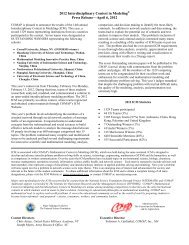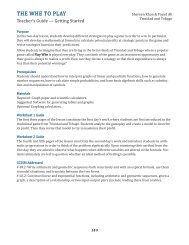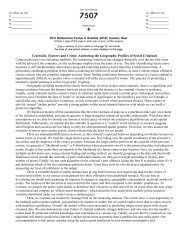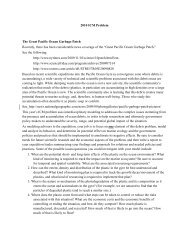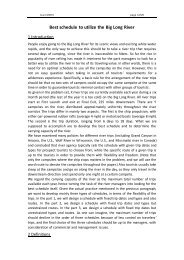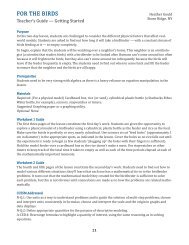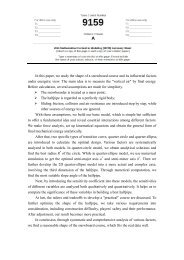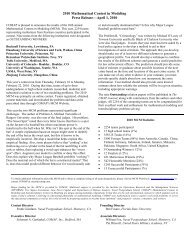Team 13955: Computing Along the Big Long River
Team 13955: Computing Along the Big Long River
Team 13955: Computing Along the Big Long River
Create successful ePaper yourself
Turn your PDF publications into a flip-book with our unique Google optimized e-Paper software.
Page 4 of 18 Control #<strong>13955</strong><br />
• Simulates river trip scheduling as a function of some distribution of trip lengths (ei<strong>the</strong>r 6, 12, or<br />
18 days), a varying distribution of propulsion, and a varying number of campsites.<br />
Ultimately, <strong>the</strong> model predicts <strong>the</strong> number of successful trips in a six month time frame. As a<br />
result of finding this number, we also answer questions about <strong>the</strong> carrying capacity of <strong>the</strong> river,<br />
advantageous distributions of propulsion and trip lengths, how many groups can start a river trip each<br />
day, and how to schedule trips in such a way that <strong>the</strong>se results are possible.<br />
1.3 Constraints<br />
The problem specifies <strong>the</strong> following constraints:<br />
• Trips begin at First Launch and end at Final Exit – exactly 225 miles downstream.<br />
• There are only two types of boats: oar-powered rubber rafts and motorized boats.<br />
• Oar-powered rubber rafts travel 4 mph on average.<br />
• Motorized boats travel 8 mph on average.<br />
• Group trips will range from 6 to 18 nights.<br />
• Trips are only scheduled during a six month period of <strong>the</strong> year.<br />
• Campsites are distributed uniformly throughout <strong>the</strong> river corridor.<br />
• No two sets of campers can occupy <strong>the</strong> same site at <strong>the</strong> same time.<br />
1.4 Assumptions<br />
• We have <strong>the</strong> ability to determine <strong>the</strong> proportion of oar-powered river rafts to motorized boats<br />
that go onto <strong>the</strong> river each day.<br />
Moving a high volume of groups down <strong>the</strong> river in a satisfactory time becomes an issue<br />
if too many oar-powered boats are launched with short trip lengths.<br />
• The duration of trips is constrained to <strong>the</strong> following values: 12 or 18 days for groups travelling<br />
by oar-powered river rafts, and 6 or 12 days for those travelling by motorized boat.<br />
This is a simplification which allows our model to produce more meaningful results<br />
while preserving <strong>the</strong> ability to compare <strong>the</strong> effect of varying inputs.<br />
• There can only be one group per campsite per night.<br />
Our algorithm only considers campsites which are empty as open campsites that groups<br />
can move to, which is consistent with <strong>the</strong> desires of <strong>the</strong> river manager.<br />
• Each day, groups may only move downstream or remain in <strong>the</strong>ir current campsite -- <strong>the</strong>y may<br />
not move back up stream.<br />
This allows us to restrict <strong>the</strong> flow of groups on <strong>the</strong> river to a single direction which<br />
greatly simplifies <strong>the</strong> ways in which we can move groups from campsite to campsite.<br />
• Groups heading downstream can only travel <strong>the</strong> river between 8am and 6pm.<br />
This amounts to a maximum of 9 hours of travel per day (one hour is subtracted for<br />
breaks/lunch/etc.). This implies that oar-powered river raft groups can travel at most 36 miles







